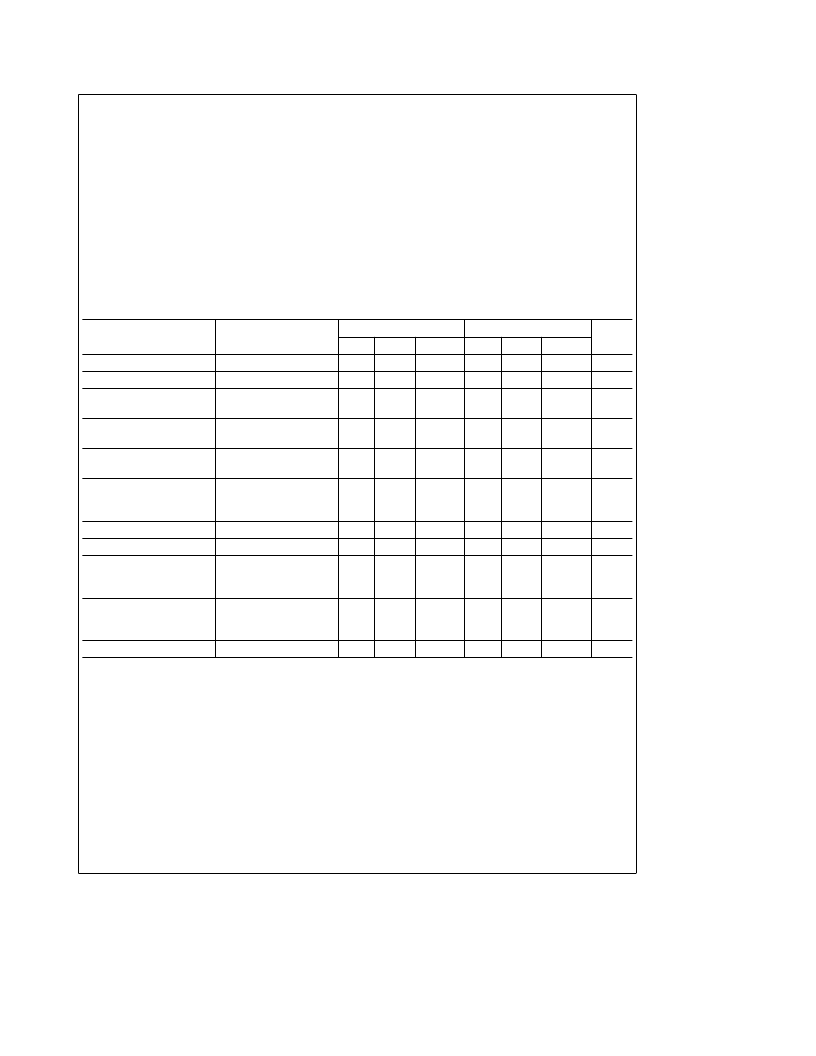- 您現(xiàn)在的位置:買賣IC網(wǎng) > PDF目錄361023 > LM104H (NATIONAL SEMICONDUCTOR CORP) Negative Regulator PDF資料下載
參數(shù)資料
| 型號(hào): | LM104H |
| 廠商: | NATIONAL SEMICONDUCTOR CORP |
| 元件分類: | 基準(zhǔn)電壓源/電流源 |
| 英文描述: | Negative Regulator |
| 中文描述: | 0.015 V-40 V ADJUSTABLE NEGATIVE REGULATOR, MBCY10 |
| 文件頁(yè)數(shù): | 2/6頁(yè) |
| 文件大?。?/td> | 161K |
| 代理商: | LM104H |

Absolute Maximum Ratings
If Military/Aerospace specified devices are required, please contact the National Semiconductor Sales Office/
Distributors for availability and specifications.
(Note 6)
LM104/LM204
50V
LM304
40V
Input Voltage
Input-Output Voltage Differential
50V
40V
Power Dissipation (Note 1)
500 mW
500 mW
Operating Temperature Range
LM104
LM204
LM304
b
55
§
C to
a
125
§
C
b
25
§
C to
a
85
§
C
0
§
C to
a
70
§
C
b
65
§
C to
a
150
§
C
300
§
C for hermetic
Storage Temperature Range
b
65
§
C to
a
150
§
C
260
§
C for plastic
Lead Temperature (Soldering, 10 sec.)
Electrical Characteristics
Parameter
Conditions
LM104/LM204
LM304
Units
Min
Typ
Max
Min
Typ
Max
Input Voltage Range
b
50
b
8
b
40
b
8
V
Output Voltage Range
b
40
b
0.015
b
30
b
0.035
V
Output-Input Voltage
Differential (Note 3)
I
O
e
20 mA
I
O
e
5 mA
2.0
0.5
50
50
2.0
0.5
40
40
V
V
Load Regulation (Note 4)
O
s
I
O
s
20 mA
R
SC
e
15
X
1
5
1
5
mV
Line Regulation (Note 5)
V
OUT
s
b
5V
D
V
IN
e
0.1 V
IN
0.056
0.1
0.056
0.1
%
Ripple Rejection
C
19
e
10
m
F, f
e
120 Hz
V
IN
k
b
15V
b
7V
t
V
IN
t
b
15V
0.2
0.5
0,.5
1.0
0.2
0.5
0.5
1.0
mV/V
mV/V
Output Voltage Scale Factor
R
2-3
e
2.4k
1.8
2.0
2.2
1.8
2.0
2.2
V/k
X
Temperature Stability
V
O
s
b
1V
0.3
1.0
0.3
1.0
%
Output Noise Voltage
10 Hz
s
f
s
10 kHz
V
O
s
b
5V, C
1-9
e
0
0.007
15
0.007
15
%
m
V
C
1-9
e
10
m
F
Standby Current Drain
I
L
e
5 mA, V
O
e
0
1.7
2.5
1.7
3.6
2.5
5.0
mA
mA
mA
V
O
e b
30V
V
O
e b
40V
3.6
5.0
Long Term Stability
V
O
s
b
1V
0.01
1.0
0.01
1.0
%
Note 1:
The maximum junction temperature of the LM104 is 150
§
C, while that of the LM204 is 125
§
C and LM304 is 100
§
C. For operating at elevated temperatures,
devices in the H10C package must be derated based on a thermal resistance of 150
§
C/W, junction to ambient, or 45
§
C/W, junction to case.
Note 2:
These specifications apply for junction temperatures between
b
55
§
C and 150
§
C (between
b
25
§
C and 100
§
C for the LM204 and 0
§
C to
a
85
§
C for the
LM304) and for input and output voltages within the ranges given, unless otherwise specified. The load and line regulation specifications are for constant junction
temperature. Temperature drift effects must be taken into account separately when the unit is operating under conditions of high dissipation.
Note 3:
When external booster transistors are used, the minimum output-input voltage differential is increased, in the worst case, by approximately 1V.
Note 4:
The output currents given, as well as the load regulation, can be increased by the addition of external transistors. The improvement factor will be roughly
equal to the composite current gain of the added transistors.
Note 5:
With zero output, the dc line regulation is determined from the ripple rejection. Hence, with output voltages between 0V and
b
5V, a dc output variation,
determined from the ripple rejection, must be added to find the worst-case line regulation.
Note 6:
Refer to RETS104X drawing for military specifications for the LM104.
2
相關(guān)PDF資料 |
PDF描述 |
|---|---|
| LM106 | Voltage Comparator |
| LM106H | Voltage Comparator |
| LM10 | Operational Amplifier and Voltage Reference |
| LM10CLN | Operational Amplifier and Voltage Reference |
| LM10CN | Operational Amplifier and Voltage Reference |
相關(guān)代理商/技術(shù)參數(shù) |
參數(shù)描述 |
|---|---|
| LM104H WAF | 制造商:Texas Instruments 功能描述: |
| LM104H/883 | 制造商:Rochester Electronics LLC 功能描述: |
| LM104H/B | 制造商:Rochester Electronics LLC 功能描述: |
| LM105 | 制造商:NSC 制造商全稱:National Semiconductor 功能描述:Voltage Regulators |
| LM105 WAF | 制造商:Rochester Electronics LLC 功能描述: |
發(fā)布緊急采購(gòu),3分鐘左右您將得到回復(fù)。